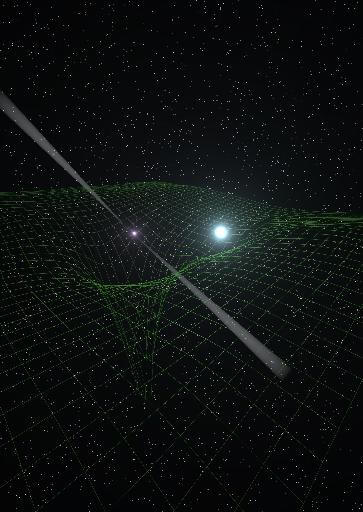A newly discovered pulsar - an orbiting neutron star with twice the mass of our Sun - and an accompanying white dwarf orbiting each other in two-and-a-half-hour cycles are helping scientists put theories to the test under the most extreme conditions

A strange pair of stars located about 7,000 light years from Earth provides scientists with a unique cosmic laboratory for testing the nature of gravity. The extremely high gravity of massive neutron stars orbiting together with white dwarfs around a common center puts various theories trying to describe gravity to the test.
And once again, Einstein's theory of general relativity published in 1915 provides the best answer. The scientists expect that at some point the theory of relativity will not meet expectations in extreme situations. General relativity, for example, is incompatible with quantum theory. Physicists hope to find a better alternative description of gravitation that will "get along" with the other theories.
Now a newly discovered pulsar - an orbiting neutron star with twice the mass of our Sun - and an accompanying white dwarf orbiting each other in two-and-a-half-hour cycles are helping scientists put the theories to the test under the most extreme conditions ever measured. However, stargazers who observed the pair of stars discovered results as predicted by the theory of general relativity and not as predicted by competing theories.
Since the star pair was discovered by the GBT telescope, various stargazers around the world have turned their gaze to it. The observations showed that there are subtle changes in the orbits of the stars.
In this type of pulsar and white dwarf system, gravitational waves are emitted that store energy within the system. By taking very precise measurements, over long time spans, by measuring the time it takes for radio pulses coming from within the pulsar to arrive, the scientists will be able to determine the amount of radiation emitted from the gravitational waves.
In these extreme conditions, there were scientists who believed that Einstein's theory of relativity would collapse and would not accurately predict the amount of gravitational radiation emitted and the subsequent decay reflected in the orbit of the stars. "We thought that this system would be extreme enough to show evidence in the theory of general relativity, but instead, Einstein's predictions stood the test perfectly," says Paul Freire, from the Max Planck Institute in Germany.

6 תגובות
"Quantum is inconsistent with general relativity"? I thought that quanta had no predictions in the field of gravity. And gravitational waves are still a theory
In my humble opinion, the interesting place to examine the theory of gravity is precisely the case of super-weak fields. And why? Since the deviation from the predictions of classical gravity on the scales of a galaxy and above (which currently leads to the hypothesis of the existence of dark matter) occurs precisely in this elusive area. On the other hand, quantum effects in gravity are obtained at the Planck scale and the day (if at all) is far from when we can touch this field of energies. In the intermediate range between very weak gravity and ultra-strong gravity, general relativity provides a reliable and accurate description of reality.
The "photo from NASA" is wrong
This is me
And how do you think the principles of equivalence are valid?
The theories of relativity follow automatically from the principles of equivalence.